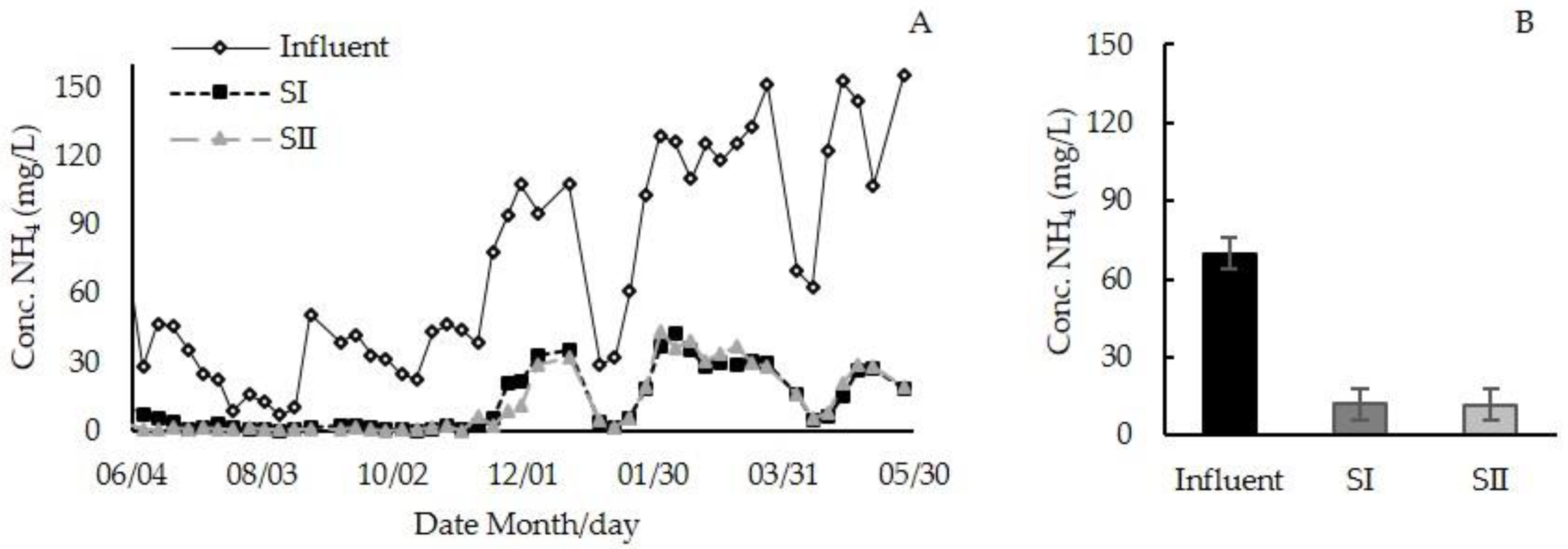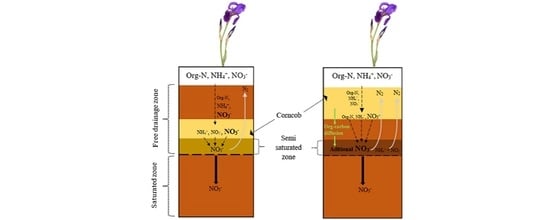Addition of Corn Cob in the Free Drainage Zone of Partially Saturated Vertical Wetlands Planted with I. sibirica for Total Nitrogen Removal—A Pilot-Scale Study
Abstract
:1. Introduction
2. Materials and Methods
2.1. Systems and Experiment Description
2.2. Water Quality Parameters and Sampling Methods
2.3. Statistical Analysis
3. Results and Discussion
3.1. Performance of the PS VF Wetlands for the Removal of Pollutants Affected Directly by the Presence of Corncob
3.1.1. BOD5
3.1.2. COD
3.1.3. TSS
3.1.4. True Color
3.2. Internal Conditions of the PS VF Wetlands
3.2.1. Parameter Measured in Situ
3.2.2. Alkalinity
3.3. Nitrogen Removal
3.3.1. Organic Nitrogen
3.3.2. Ammonium
3.3.3. Nitrite
3.3.4. Nitrate
3.3.5. Total Nitrogen Removal
4. Conclusions
Author Contributions
Funding
Acknowledgments
Conflicts of Interest
References
- Zhou, X.; Wang, X.; Zhang, H.; Wu, H. Enhanced nitrogen removal of low C/N domestic wastewater using a biochar-amended aerated vertical flow constructed wetland. Bioresour. Technol. 2017, 241, 269–275. [Google Scholar] [CrossRef] [PubMed]
- Luo, Z.; Li, S.; Zhu, X.; Ji, G. Carbon source effects on nitrogen transformation processes and the quantitative molecular mechanism in long-term flooded constructed wetlands. Ecol. Eng. 2018, 123, 19–29. [Google Scholar] [CrossRef]
- Saeed, T.; Sun, G. A comparative study on the removal of nutrients and organic matter in wetland reactors employing organic media. Chem. Eng. J. 2011, 171, 439–447. [Google Scholar] [CrossRef]
- Stieglmeier, M.; Klingl, A.; Alves, R.J.E.; Rittmann, S.K.M.R.; Melcher, M.; Leisch, N.; Schleper, C. Nitrososphaera viennensis gen. nov., sp. nov., an aerobic and mesophilic, ammonia-oxidizing archaeon from soil and a member of the archaeal phylum Thaumarchaeota. Int. J. Syst. Evol. Microbiol. 2014, 64, 2738–2752. [Google Scholar] [CrossRef] [PubMed]
- Pelissari, C.; Guivernau, M.; Vinas, M.; Garcia, J.; Velasco-Galilea, M.; Souza, S.S.; Sezerino, P.H.; Avila, C. Effects of partially saturated conditions on the metabolically active microbiome and on nitrogen removal in vertical subsurface flow constructed wetlands. Water Res. 2018, 141, 185–195. [Google Scholar] [CrossRef] [PubMed]
- Wang, W.; Ding, Y.; Wang, Y.; Song, X.; Ambrose, R.F.; Ullman, J.L. Intensified nitrogen removal in immobilized nitrifier enhanced constructed wetlands with external carbon addition. Bioresour. Technol. 2016, 218, 1261–1265. [Google Scholar] [CrossRef]
- Zhou, X.; Liang, C.; Jia, L.; Feng, L.; Wang, R.; Wu, H. An innovative biochar-amended substrate vertical flow constructed wetland for low C/N wastewater treatment: Impact of influent strengths. Bioresour. Technol. 2018, 247, 844–850. [Google Scholar] [CrossRef]
- Daims, H.; Lebedeva, E.V.; Pjevac, P.; Han, P.; Herbold, C.; Albertsen, M.; Jehmlich, N.; Palatinszky, M.; Vierheilig, J.; Bulaev, A.; et al. Complete nitrification by Nitrospira bacteria. Nature 2015, 528, 504–509. [Google Scholar] [CrossRef]
- Xia, F.; Wang, J.-G.; Zhu, T.; Zou, B.; Rhee, S.-K.; Quan, Z.-X. Ubiquity and Diversity of Complete Ammonia Oxidizers (Comammox). Appl. Environ. Microbiol. 2018, 84, e01390-18. [Google Scholar] [CrossRef]
- Lei, Y.; Wang, Y.; Liu, H.; Xi, C.; Song, L. A novel heterotrophic nitrifying and aerobic denitrifying bacterium, Zobellella taiwanensis DN-7, can remove high-strength ammonium. Appl. Microbiol. Biotechnol. 2016, 100, 4219–4229. [Google Scholar] [CrossRef]
- Sun, Z.; Lv, Y.; Liu, Y.; Ren, R. Removal of nitrogen by heterotrophic nitrification-aerobic denitrification of a novel metal resistant bacterium Cupriavidus sp. S1. Bioresour. Technol. 2016, 220, 142–150. [Google Scholar] [CrossRef] [PubMed]
- Yang, Z.; Yang, L.; Wei, C.; Wu, W.; Zhao, X.; Lu, T. Enhanced nitrogen removal using solid carbon source in constructed wetland with limited aeration. Bioresour. Technol. 2018, 248, 98–103. [Google Scholar] [CrossRef] [PubMed]
- Sun, H.; Yang, Z.; Wei, C.; Wu, W. Nitrogen removal performance and functional genes distribution patterns in solid-phase denitrification sub-surface constructed wetland with micro aeration. Bioresour. Technol. 2018, 263, 223–231. [Google Scholar] [CrossRef] [PubMed]
- Kozlowski, J.A.; Price, J.; Stein, L.Y. Revision of N2O-producing pathways in the ammonia-oxidizing bacterium Nitrosomonas europaea ATCC 19718. Appl. Environ. Microbiol. 2014, 80, 4930–4935. [Google Scholar] [CrossRef] [PubMed]
- Qin, Y.; Cao, Y.; Ren, J.; Wang, T.; Han, B. Effect of glucose on nitrogen removal and microbial community in anammox-denitrification system. Bioresour. Technol. 2017, 244, 33–39. [Google Scholar] [CrossRef] [PubMed]
- Qiao, S.; Yin, X.; Zhou, J.; Wei, L.; Zhong, J. Integrating anammox with the autotrophic denitrification process via electrochemistry technology. Chemosphere 2018, 195, 817–824. [Google Scholar] [CrossRef]
- Pelissari, C.; Avila, C.; Trein, C.M.; Garcia, J.; de Armas, R.D.; Sezerino, P.H. Nitrogen transforming bacteria within a full-scale partially saturated vertical subsurface flow constructed wetland treating urban wastewater. Sci. Total Environ. 2017, 574, 390–399. [Google Scholar] [CrossRef] [Green Version]
- Dotro, G.; Langergraber, G.; Molle, P.; Nivala, J.; Puigagut, J.; Stein, O.; von Sperling, M. Treatment Wetlands; IWA Publishing: London, UK, 2017. [Google Scholar]
- Si, Z.; Song, X.; Wang, Y.; Cao, X.; Zhao, Y.; Wang, B.; Chen, Y.; Arefe, A. Intensified heterotrophic denitrification in constructed wetlands using four solid carbon sources: Denitrification efficiency and bacterial community structure. Bioresour. Technol. 2018, 267, 416–425. [Google Scholar] [CrossRef]
- Al-Saedi, R.; Smettem, K.; Siddique, K.H.M. Nitrogen removal efficiencies and pathways from unsaturated and saturated zones in a laboratory-scale vertical flow constructed wetland. J. Environ. Manag. 2018, 228, 466–474. [Google Scholar] [CrossRef]
- Saeed, T.; Sun, G. Pollutant removals employing unsaturated and partially saturated vertical flow wetlands: A comparative study. Chem. Eng. J. 2017, 325, 332–341. [Google Scholar] [CrossRef]
- Sgroi, M.; Pelissari, C.; Roccaro, P.; Sezerino, P.H.; García, J.; Vagliasindi, F.G.A.; Ávila, C. Removal of organic carbon, nitrogen, emerging contaminants and fluorescing organic matter in different constructed wetland configurations. Chem. Eng. J. 2018, 332, 619–627. [Google Scholar] [CrossRef] [Green Version]
- Wang, S.; Lin, X.; Yu, H.; Wang, Z.; Xia, H.; An, J.; Fan, G. Nitrogen removal from urban stormwater runoff by stepped bioretention systems. Ecol. Eng. 2017, 106, 340–348. [Google Scholar] [CrossRef]
- Li, H.; Chi, Z.; Yan, B.; Cheng, L.; Li, J. An innovative wood-chip-framework substrate used as slow-release carbon source to treat high-strength nitrogen wastewater. J. Environ. Sci. 2017, 51, 275–283. [Google Scholar] [CrossRef]
- Shen, Z.; Zhou, Y.; Liu, J.; Xiao, Y.; Cao, R.; Wu, F. Enhanced removal of nitrate using starch/PCL blends as solid carbon source in a constructed wetland. Bioresour. Technol. 2015, 175, 239–244. [Google Scholar] [CrossRef] [PubMed]
- Martínez, N.B.; Tejeda, A.; Del Toro, A.; Sánchez, M.P.; Zurita, F. Nitrogen removal in pilot-scale partially saturated vertical wetlands with and without an internal source of carbon. Sci. Total Environ. 2018, 645, 524–532. [Google Scholar] [CrossRef]
- Tejeda, A.; Barrera, A.; Zurita, F. Adsorption Capacity of a Volcanic Rock—Used in ConstructedWetlands—For Carbamazepine Removal, and Its Modification with Biofilm Growth. Water 2017, 9, 721. [Google Scholar] [CrossRef]
- Federation, W.E.; Association, A.P.H. Standard Methods for the Examination of Water and Wastewater; American Public Health Association: Washington, DC, USA, 2005. [Google Scholar]
- Metacalf, E.; Eddy, H. Wastewater Engineering-Treatment, Disposal, Reuse; McGraw Hill: New York, NY, USA, 1991. [Google Scholar]
- Huang, M.; Wang, Z.; Qi, R. Enhancement of the complete autotrophic nitrogen removal over nitrite process in a modified single-stage subsurface vertical flow constructed wetland: Effect of saturated zone depth. Bioresour. Technol. 2017, 233, 191–199. [Google Scholar] [CrossRef]
- Vymazal, J.; Kröpfelová, L. Wastewater Treatment in Constructed Wetlands with Horizontal Sub-Surface Flow; Springer Netherlands: Dordrecht, The Netherlands, 2008; Volume 14. [Google Scholar]
- Pellera, F.-M.; Gidarakos, E. Chemical pretreatment of lignocellulosic agroindustrial waste for methane production. Waste Manag. 2018, 71, 689–703. [Google Scholar] [CrossRef]
- Kadlec, R.H.; Wallace, S. Treatment Wetlands; CRC Press: Boca Raton, FL, USA, 2008. [Google Scholar]
- Li, F.; Lu, L.; Zheng, X.; Ngo, H.H.; Liang, S.; Guo, W.; Zhang, X. Enhanced nitrogen removal in constructed wetlands: Effects of dissolved oxygen and step-feeding. Bioresour. Technol. 2014, 169, 395–402. [Google Scholar] [CrossRef]
- Herouvim, E.; Akratos, C.S.; Tekerlekopoulou, A.; Vayenas, D.V. Treatment of olive mill wastewater in pilot-scale vertical flow constructed wetlands. Ecol. Eng. 2011, 37, 931–939. [Google Scholar] [CrossRef]
- Zurita, F.; Del Toro-Sánchez, C.L.; Gutierrez-Lomelí, M.; Rodriguez-Sahagún, A.; Castellanos-Hernandez, O.A.; Ramírez-Martínez, G.; White, J.R. Preliminary study on the potential of arsenic removal by subsurface flow constructed mesocosms. Ecol. Eng. 2012, 47, 101–104. [Google Scholar] [CrossRef]
- Li, B.; Irvin, S. The comparison of alkalinity and ORP as indicators for nitrification and denitrification in a sequencing batch reactor (SBR). Biochem. Eng. J. 2007, 34, 248–255. [Google Scholar] [CrossRef]
- Murphy, C.; Rajabzadeh, A.R.; Weber, K.P.; Nivala, J.; Wallace, S.D.; Cooper, D.J. Nitrification cessation and recovery in an aerated saturated vertical subsurface flow treatment wetland: Field studies and microscale biofilm modeling. Bioresour. Technol. 2016, 209, 125–132. [Google Scholar] [CrossRef] [PubMed]
- Anukam, A.I.; Goso, B.P.; Okoh, O.O.; Mamphweli, S.N. Studies on Characterization of Corn Cob for Application in a Gasification Process for Energy Production. J. Chem. 2017. [Google Scholar] [CrossRef]
- Hu, Y.; He, F.; Ma, L.; Zhang, Y.; Wu, Z. Microbial nitrogen removal pathways in integrated vertical-flow constructed wetland systems. Bioresour. Technol. 2016, 207, 339–345. [Google Scholar] [CrossRef]
- Kumar, M.; Lin, J.G. Co-existence of anammox and denitrification for simultaneous nitrogen and carbon removal--Strategies and issues. J. Hazard. Mater. 2010, 178, 1–9. [Google Scholar] [CrossRef]
- Ji, Q.; Babbin, A.R.; Jayakumar, A.; Oleynik, S.; Ward, B.B. Nitrous oxide production by nitrification and denitrification in the Eastern Tropical South Pacific oxygen minimum zone. Geophys. Res. Lett. 2015, 42, 10755–710764. [Google Scholar] [CrossRef]
- Fu, G.; Huangshen, L.; Guo, Z.; Zhou, Q.; Wu, Z. Effect of plant-based carbon sources on denitrifying microorganisms in a vertical flow constructed wetland. Bioresour. Technol. 2017, 224, 214–221. [Google Scholar] [CrossRef]
- Qiu, S.; Hu, Y.; Liu, R.; Sheng, X.; Chen, L.; Wu, G.; Hu, H.; Zhan, X. Start up of partial nitritation-anammox process using intermittently aerated sequencing batch reactor: Performance and microbial community dynamics. Sci. Total Environ. 2019, 647, 1188–1198. [Google Scholar] [CrossRef]
- Langergraber, G.; Pressl, A.; Leroch, K.; Rohrhofer, R.; Haberl, R. Long-term behaviour of a two-stage CW system regarding nitrogen removal. Water Sci. Technol. 2011, 64, 1137–1141. [Google Scholar] [CrossRef]
- Silveira, D.D.; Belli Filho, P.; Philippi, L.S.; Kim, B.; Molle, P. Influence of partial saturation on total nitrogen removal in a single-stage French constructed wetland treating raw domestic wastewater. Ecol. Eng. 2015, 77, 257–264. [Google Scholar] [CrossRef]
- Canga, E.; Dal Santo, S.; Pressl, A.; Borin, M.; Langergraber, G. Comparison of nitrogen elimination rates of different constructed wetland designs. Water Sci. Technol. 2011, 64, 1122–1129. [Google Scholar] [CrossRef] [PubMed]














| Parameter | Influent |
|---|---|
| Oxygen demand (BOD5, mg/L) | 61 ± 54 |
| Chemical oxygen demand (COD, mg/L) | 136 ± 85 |
| TSS (mg/L) | 43 ± 33 |
| Org-N (mg/L) | 4.5 ± 2.8 |
| NH4+ (mg/L) | 69.7 ± 46.0 |
| NO2− (mg/L) | 0.05 ± 0.1 |
| NO3− (mg/L) | 10.8 ± 11.0 |
| Total nitrogen (TN, mg/L) | 85.3 ± 57.2 |
| Color (PtCo unit) | 264.8 ± 30.7 |
| Alkalinity (mg/L as CaCO3) | 558 ± 226.0 |
| pH | 7.8 ± 0.2 |
| Electric conductivity (EC, µS/cm) | 1198 ± 587 |
© 2019 by the authors. Licensee MDPI, Basel, Switzerland. This article is an open access article distributed under the terms and conditions of the Creative Commons Attribution (CC BY) license (http://creativecommons.org/licenses/by/4.0/).
Share and Cite
Del Toro, A.; Tejeda, A.; Zurita, F. Addition of Corn Cob in the Free Drainage Zone of Partially Saturated Vertical Wetlands Planted with I. sibirica for Total Nitrogen Removal—A Pilot-Scale Study. Water 2019, 11, 2151. https://doi.org/10.3390/w11102151
Del Toro A, Tejeda A, Zurita F. Addition of Corn Cob in the Free Drainage Zone of Partially Saturated Vertical Wetlands Planted with I. sibirica for Total Nitrogen Removal—A Pilot-Scale Study. Water. 2019; 11(10):2151. https://doi.org/10.3390/w11102151
Chicago/Turabian StyleDel Toro, Aarón, Allan Tejeda, and Florentina Zurita. 2019. "Addition of Corn Cob in the Free Drainage Zone of Partially Saturated Vertical Wetlands Planted with I. sibirica for Total Nitrogen Removal—A Pilot-Scale Study" Water 11, no. 10: 2151. https://doi.org/10.3390/w11102151
APA StyleDel Toro, A., Tejeda, A., & Zurita, F. (2019). Addition of Corn Cob in the Free Drainage Zone of Partially Saturated Vertical Wetlands Planted with I. sibirica for Total Nitrogen Removal—A Pilot-Scale Study. Water, 11(10), 2151. https://doi.org/10.3390/w11102151







